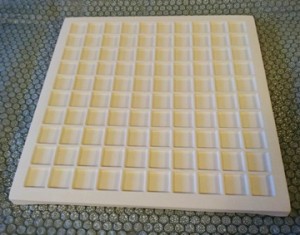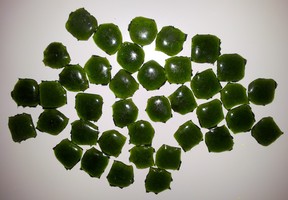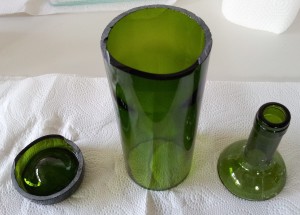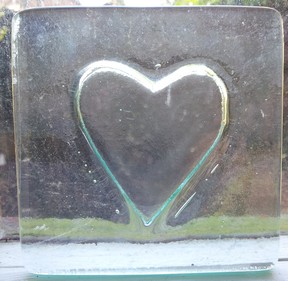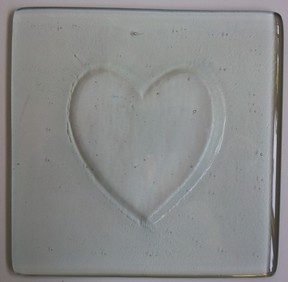I must apologize for my lack of posts over the last few weeks but, after a rather intense session on my day job, I’m back!
Since I got started on my glass journey I have been wondering how I can recycle all the wine and beer bottles we accumulated over Christmas.
Thinking what fun it would be to make some mosaic tiles of various glassy hues, I sent for a clay mosaic mold.
I then proceeded to smash up a carefully cleaned and de-labelled wine bottle and, mixing it with a little water (to keep the glass dust down) I loaded teaspoonfuls of the glassy paste into the mould.
Following a firing schedule for recycled glass in one of my glass books, I set the kiln going and kept my fingers crossed.
Disappointment!!
Despite the higher temperature and long soak time prescribed, the glass had not fully fused and not run to the edges of the mould. I put it all in again but this time devitification had triumphed and I dumped the whole lot in the bin, vowing to take the rest of the bottles to the bottle bank.
But then I remembered reading that a standard tile cutter with a diamond blade was good for glass cutting. So, having sourced a second hand cutter, I got togged up in goggles, leather gloves and apron and called my other half to standby in case of injury. I really couldn’t believe that I was the only one who thought this was a good idea!!
But despite the rather wet jeans and shower of ground glass, the cutting was remarkably easy.
The centre section and base of the bottle is cooking as I write with a top temp of 804C and a soak time of 60 mins. I have laid the centre on its side and am hoping for a nice flat slab by tomorrow morning. I don’t know what the base will do but we shall see.
I have also been experimenting with the glass I was given (with unknown co-efficient of expansion) and some 6mm fibre paper.
This was made with two slabs of 4mm glass with the 6mm fibre heart positioned underneath. At first I thought that the two marks on the lower right of the heart were cracks but on closer inspection I found they were long bubbles.
This is a larger slab also made of 2 4mm slabs and it didn’t fare so well after 2 fusings. The glass has become stressed around the top edges of the heart and the small bubbles that were apparent after fusing have already began to run into cracks! There is also some evidence of tin bloom which is apparently common in window glass after a few fusings!

